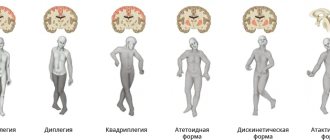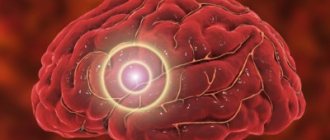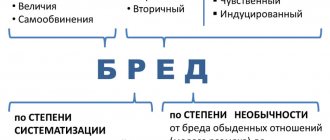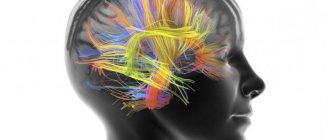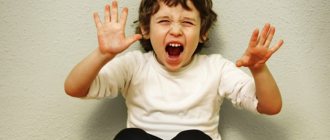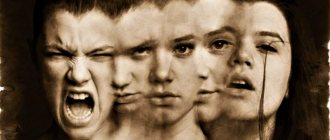Schizophrenia in children – a mental disorder with psychotic symptoms and a chronic course. It manifests itself as a distortion of perception, disruption of associative processes, flattening of affect, emotional coldness, autism, ambivalence of motives and actions.
The main diagnostic methods are clinical, clinical-biographical, and psychological. The basis of pharmacological treatment is drugs from the neuroleptic group. Individual, group and family psychotherapy is carried out, aimed at correcting cognitive deficits and restoring social interaction skills.
Classification and clinical forms
Schizophrenia in children manifests itself in the following forms:
- paranoid (too strong fantasies, delusions, obsessions, anorexia, pathological dissatisfaction with oneself, especially in teenage girls);
- malignant (begins at an early age, is characterized by a sharp predominance of negative symptoms, loss of speech occurs);
- recurrent (hallucinations, delusions, catatonic stupor);
- paroxysmal-progressive;
- sluggish (the most common variant in children, very often the characteristics coincide with special giftedness; such children are ahead of their peers on several points of development and are even considered child prodigies).
Of course, if several signs are detected, you should not draw disappointing conclusions. Teenage girls are characterized by maximalism; they only want to be dazzlingly beautiful and nothing else. They do not yet fully realize that there are no perfect people.
Types of disease and first signs in children
Statistics show that adolescents are prone to acquiring one of six types of schizophrenia (which, in turn, are divided according to their course into paroxysmal and continuous):
- Simple schizophrenia. For the first time it manifests itself in the form of a child’s complex character and uncontrollable outbursts of aggression. Then the quantity and quality of interests decreases sharply.
- Paranoid schizophrenia. In adolescents, the symptoms and signs of the disease begin with severe delirium and dysmorphomania, when the child discovers a non-existent defect in his appearance. Events are misinterpreted and personal experiences are completely distorted.
- Catatonic schizophrenia. A very rare species that can be distinguished by the teenager’s habit of freezing in unusual positions, falling into frequent stupor and negativism. Unproductive movement activity is noted.
- Residual schizophrenia. Practically does not appear. The main signs are considered to be a disdainful attitude towards one's appearance, extremely little social activity and general lethargy.
- Hebephrenic schizophrenia. Characterized by childish behavior such as grimacing and mannerisms. Extreme manifestations of autism are noticeable.
- Sluggish schizophrenia. Weakly manifested at a young age. Signs and symptoms of sluggish schizophrenia in a teenager are practically not expressed in any way; only indirect clinical manifestations are characteristic. Children, to one degree or another, understand what is happening around them and can give a description of it.
How to recognize schizophrenia in a child
Even in adult practice, there is no symptom that will clearly indicate whether a person has schizophrenia or not. The specialist always focuses on the totality of symptoms, their development over time and the order of appearance. Against the backdrop of an undeveloped child’s psyche, this is especially important.
Pediatric schizophrenia symptoms and signs are divided into:
- simple - there are no delusions and hallucinations, the leading symptoms are depression of will, motivation and flattening, impoverishment of emotions. Children with this form are very susceptible to treatment;
- hebephrenic - pretentious antics, protest, impulsiveness, aggression towards oneself and others come to the fore. Without treatment, such children are practically unlearnable and dangerous to themselves and others.
- catatonic - children maintain pretentious poses that are given to them, wave their arms or sway, shout or jabber monotonously, flatly refuse to talk, repeat the words, facial expressions, and movements of those around them.
Features of pathology in adolescents
The signs of childhood schizophrenia in adolescence are somewhat different. In addition to the listed symptoms, patients experience disinhibition of simple reflexes (increased appetite, sexual preoccupation); delusions and pseudohallucinations may appear. Teenagers often become uncontrollable, refuse to communicate with their parents, and commit antisocial acts. Patients stop attending school, express complete indifference to current events, and have a disorder of thinking.
How is schizophrenia transmitted?
There is no confirmed evidence of the genetic nature of this pathology. There are only versions of how schizophrenia is inherited, based on observations of families with a mental disorder in one (or more) of the relatives. The risk of brain disorders increases if a parent or grandparent is diagnosed with the disease. Multiple cases of the disease in a family significantly increase the likelihood of its development in a child (almost 50%).
Features of the course of the disease
Adolescent schizophrenia is associated with the development of pathologies in a child that cause deviations in emotional and mental health, and also distort, in connection with this, an adequate perception of the surrounding reality. There is a similarity between the primary signs of schizophrenia and psychopathy:
- practice of various sexual deviations;
- aggressive behavior and disobedience;
- refusal to attend school classes.
Among the pronounced symptoms of schizophrenia in adolescents, pronounced autism, decreased physical and mental activity, and an explosive build-up of negative emotions are usually identified. Persecution mania and hallucinations, on the contrary, are practically uncharacteristic for adolescents.
Pathogenesis
The following developmental mechanisms play a role in the pathogenesis of early childhood schizophrenia:
- oxygen starvation of brain cells, especially affecting the period of growth and development of tissues and organs of the child’s nervous system;
- genetic changes due to toxic effects on the embryo - primarily mutations in the short arm of chromosome 6;
- dysfunction of neurotransmitters - increased activity of dopamine, decreased activity of glutamate receptors.
Causes of development of schizophrenia in children
Many research studies have been conducted to find out why schizophrenia occurs. The childhood type of the disease is not very different from the adult forms of the disease. However, it has a poorer prognosis due to its early development. Despite the efforts of scientists, it was not possible to identify the exact cause of the disease. However, psychiatrists point to a number of factors that increase the risk of developing schizophrenia in children. These include:
- Family history of this disease. In most cases, the patients had family members who suffered from schizophrenia. The risk of pathology increases not only if the parents have the disease, but also among other family members. It has been revealed that there is a special gene responsible for the development of schizophrenia.
- Adverse effects on the embryo during the formation of organs. Damaging factors include medications, drugs, alcohol, ionizing radiation, and chemicals. These effects are especially dangerous in the first trimester of pregnancy. After all, at this moment the formation of the nervous system occurs.
- Late pregnancy. Conceiving a child over the age of 35 increases the risk of developing mental pathologies in the fetus.
- Chronic infectious diseases in a pregnant woman.
- Staying in stressful conditions. It is worth remembering that nervous overstrain while carrying a child affects not only the condition of the pregnant woman, but also has a detrimental effect on the fetus.
Although it is impossible to determine the exact cause, it is worth taking measures to eliminate all risk factors.
Signs in babies
In some cases, it is possible to identify obvious mental disorders in a child even before he turns 2 years old. The most noticeable symptoms are strange behavior: for example, a clearly focused gaze literally from birth, as if the child is looking at a non-existent object. And this despite the fact that many babies simply cannot do this.
With the further development of the child, the pathology becomes more and more obvious. A typical sign of schizophrenia is delays in the development of speech and motor skills , although by themselves they do not mean anything. Clumsiness and slowness are very noticeable in their movements; in addition, such children usually do not know how to build interpersonal relationships.
In general, the behavior of the kids seems very eccentric. Their former lethargy, observed in the first months of life, is replaced by slight excitability, a tendency to aggression and screaming, but at the same time - comparative coldness towards their parents. Such a child is capable of getting carried away by his activities to the point of obsession, and in games he usually does not look for company, and generally does not think about the interests of others. Sometimes schizophrenia is accompanied by an oligophrenia-like defect , which is characterized by low memory capabilities and general naivety.
Signs of schizophrenia in teenagers
In adolescence, mental disorder manifests itself in detachment from the team. Sick children are reluctant to communicate, have poor contact with peers, are not interested in extracurricular activities, and are not inclined to attend sections and clubs. There is a desire for loneliness. Emotional indifference develops, there are fewer emotions, they are less vivid than in healthy children.
Children with the diagnosis do not study well. They are inclined to believe that they are doing everything worse than others, and to suspect others of having a bad attitude. Old interests are replaced by new, manic ones.
Perception disturbances occur. Auditory and, less commonly, visual hallucinations and delusions may appear. Difficulties arise in distinguishing between reality and dreams and fantasies.
Preventing symptoms and signs of schizophrenia
First of all, parents must convey to their teenagers the need to limit the use of alcohol and drugs. Sometimes the signs of schizophrenia in adolescents at the age of 15 can be confused with the usual transitional age period, which some children experience too violently and emotionally.
The work of a psychotherapist as a preventative measure includes giving lectures on a healthy lifestyle, teaching formal contacts with other people and teaching self-care and monitoring one’s own appearance. The child must learn to control his emotions and behavior, communicate with people around him and independently solve assigned tasks.
What parents should pay attention to
- conflicting judgments;
- difficulties in communicating with others;
- presence of an inferiority complex;
- impaired thinking, inability to adequately answer questions;
- impaired speech (too fast, slow and drawn out);
- association of neologisms;
- lack of intellectual thinking and interest;
- apathy and obsessive states;
- a psyche poor in emotions;
- periodic loss of comprehension of what was said or heard;
- overly emotional perception of failures at school;
- absent-mindedness, aimless existence;
- pathological egoism.
How does autism manifest in childhood schizophrenia?
Previously, autism was considered one of the criteria for schizophrenia in childhood. Currently, this disorder is identified as a separate disease. Autism is a disorder in a child's ability to socially interact. In addition, the pathology is characterized by impoverishment or absence of the emotional background and speech reactions addressed to others. Childhood schizophrenia is often accompanied by signs of autism. However, it is not the only manifestation of the pathology and is mild in severity.
Schizophrenia in children: description of pathology
Childhood schizophrenia is considered a common mental pathology. On average, it affects about 1% of young patients. Such a high incidence rate is due to the fact that it is impossible to diagnose the disease before the clinical picture develops. Also, it is impossible to assume the occurrence of schizophrenia during the period of intrauterine development, especially in the absence of a burdened anamnesis for this pathology. Some time ago, this diagnosis was made for almost any mental disorder present in a child. Currently, there are clear criteria that characterize this disease. Childhood schizophrenia is a severe mental pathology characterized by a chronic and progressive course. Common symptoms of the disease are: behavioral and thinking disorders, changes in the emotional background, hallucinatory syndrome, catatonia, delusional ideas, etc. Signs of childhood schizophrenia can be different. First of all, it depends on the form of the pathology.
Risk factors
Although the exact cause of schizophrenia is unknown, several factors seem to increase the risk of developing or triggering schizophrenia, including:
- A family history of people suffering from schizophrenia.
- Exposure to viruses, toxins, or malnutrition during fetal development.
- Abnormal activation of the immune system, due to inflammation or autoimmune diseases.
- Old age of the father.
- Use of psychotropic drugs in adolescence.
Symptoms of schizophrenia usually begin in the late teens to mid-30s. Childhood schizophrenia is a rare diagnosis. Early onset schizophrenia occurs in children under 17 years of age. But schizophrenia under the age of 13 is a very rare occurrence.
Actions upon detection of the first signs of disease
Doctors mainly use psychological methods to detect the disease at an early stage. If it is not possible to make an unambiguous diagnosis based on the presence of only some signs of schizophrenia and the behavior of a teenager, modern medicine suggests conducting a comprehensive examination that can clarify a number of necessary parameters.
In addition, special tests are carried out, thanks to which doctors detect any deviations from the norm in the child. In particular, according to the drawings of the observed patient, his disposition to the presence of mental disorders, including schizophrenia, is determined. However, this technique does not give a complete picture of what is happening, that is, it cannot be used to make a diagnosis without the presence of cumulative signs.
Diagnosis of childhood schizophrenia
Diagnosis of the disorder in children is based on visible symptoms. There are no special clinical methods for detecting the disease. Psychological techniques are used to identify pathology. In addition to them, comprehensive diagnostics include:
- MRI, which allows us to identify changes in the structure of the brain typical of schizophrenia and exclude the presence of possible tumors.
- Electrical encephalography, reflecting a picture of brain activity.
- Duplex scanning of blood vessels, diagnosing the presence of possible diseases - pathologies of venous outflow, atherosclerosis, etc.
- Neurotest, which allows you to track the effectiveness of the functions of the nervous system.
- Laboratory tests for the presence of traces of drugs and the Epstein-Barr virus.
When diagnosing schizophrenia, the method of studying the drawings of patients is used. It is difficult to identify pathology from a drawing alone, but creative work can display possible signs of the disorder. A common symptom of the disease is an unnatural combination of colors: grass is black, clouds are red.
How to treat?
In addition to basic treatment, the child requires special care (regular feeding, hygiene), and the creation of an emotional atmosphere favorable for him. In particularly difficult cases, with suicidal tendencies or if there is a risk of harm to oneself or others, the child is limited in movement and placed in an isolated room. This requires special permission from the relevant authorities.
Forecast
The doctor will be able to give an accurate prognosis only after studying the medical history and conducting diagnostics. A mild form or timely detection of the disease usually allows the child to get rid of most symptoms and live a normal life without limiting himself in any way.
With a more serious development of schizophrenia, the child may be deprived of the opportunity to attend a general education institution, since he is capable of harming himself or the people around him. In such cases, he has to learn to write, read and feel at home. Most often, children with such disabilities can communicate normally with people if they receive the necessary treatment.
The main task of parents is to give maximum attention to the child. Children with schizophrenia are especially vulnerable. Therefore, it is necessary to be understanding, be gentle with them and show your love so that they can feel it. If treatment does not produce results and the child shows aggression, you should still adhere to the right position, radiating only goodness.
Causes of disease manifestation in adolescents
Factors that provoke teenage schizophrenia are divided into 2 groups: biological and social.
Among biological provocateurs, the most common cause is the onset of puberty, or more precisely, the endocrine surge that accompanies this process. A hormonal storm triggers a genetic predisposition, and if the disease develops in childhood, it worsens during puberty.
Other biological factors that trigger the process include:
- hyperthermia caused by a viral infection of unknown etiology;
- TBI;
- prolonged exposure to the sun;
- large doses of alcohol and intoxicants taken for the first time, accompanied by deep intoxication.
The social environment and social norms can also influence the manifestation of schizophrenia in adolescence. This is a stage in a child’s life when his interests change, he strives to be independent and isolates himself from his parents, spending more time with peers. In addition, at this time the process of puberty begins. All these innovations are imprinted on the character of the teenager and his personality.
Teenagers react quite sharply to changes in environment and life circumstances. Transferring to another school, entering a university or technical school, moving, accompanied by entering an unfamiliar environment. The need to establish new contacts often becomes a difficult test for the psyche.
Psychotraumatic factors also play an important role in the development of schizophrenia. Thus, the teenager’s disease manifested itself after the arrest of his father, who was a significant, authoritative figure for him. For another boy, the impetus was the theft of his favorite motorcycle. In other cases, it was mental trauma, combined with fear and pain: beating or ridicule by peers, road accidents, etc.
Heredity is another established factor in the development of schizophrenia. If a teenager’s family has a similar disorder, his or her risk of developing the disease increases significantly. It has been established that if a child with a history of schizophrenia in his family ends up in a foster family that does not have such aggravating circumstances, he will still fall ill.
Upbringing also leaves its mark on the adolescent’s psyche, especially the relationship with the mother. There is such a thing as “the mother of a schizophrenic.” This is a certain model of maternal character that influences the development of schizophrenia in a child. Such a woman takes the position of leader in the family, is extremely touchy and suspicious, and does not take into account the opinions of other family members. She surrounds her child with excessive care. She is not critical of her child's behavior. There is a pathological attachment between her and the child. On the one hand, he can treat his mother rudely and harshly, but on the other hand, he can be emotionally dependent on her.
Psychotherapy
Psychotherapeutic work with schizophrenic children is successfully and effectively practiced using behavioral models: “token policy”, “intensified correction”, “removal technique”, “payment for misconduct”.
Methods of creative self-expression turned out to be no less effective: elements of art therapy, psychodramatic performances, body-oriented techniques, examples of dance, integrative therapy, as well as other existential methods.
Tips for parents
Raising and living together with a child with schizophrenia is quite a difficult task and requires great willpower and patience. The most important thing parents need to do is accept their son or daughter's diagnosis and believe in the success of therapy.
Here are some expert tips:
- There is no need to argue with your child about his hallucinations. For children diagnosed with schizophrenia, their visions are part of reality;
- try to create a comfortable regime and environment so that the child does not experience unnecessary emotional overload;
- try to protect the child from himself during psychosis.
It is important to diagnose the disease in time and begin its treatment. The future of the child largely depends on this. Therefore, if you notice repeated oddities in a child’s behavior, you should consult a doctor without waiting for the first manifestations of the disease.
Related posts:
- Can dementia be cured at home? Dementia is acquired dementia, a persistent decline in cognitive activity with loss...
- Treatment of schizophrenia with insulin coma - how effective is the method of the past? Schizophrenia is a mental illness that is observed more often than other mental illnesses, usually...
- Symptoms of stress Modern people are almost always in a state of stress. Main source...
- Organic depressive-anxiety disorder Anxiety disorders are a group of neurotic disorders with diverse symptoms….
Further life of a teenager
Certain difficulties as a child diagnosed with schizophrenia grows up are unlikely to be avoided. Nevertheless, compliance with all recommendations prescribed by the doctor, adequate and timely therapy, visiting specialists and monitoring even the most minor changes in the teenager’s behavior leaves the possibility for the child to fully exist in the future.
In the modern world, one can find completely different attitudes towards problems of the mind - from complete rejection to sincere understanding and empathy. It is impossible to predict with absolute accuracy the diagnosis of schizophrenia, but in many cases parents are able to provide comfortable conditions for a normal lifestyle and further development of a teenager.
